1-2-1-1 Full Court Zone Press
The 1-2-1-1 Full Court Zone Press is one of the more utilised rotations for defensive trapping systems in the full court. Often used as a common alternative to the 1-2-2 alignment to try and extended defenders further down the court and limit options used by offensive teams to make long passes over the head of the last line of defenders.
The alignment described within the scenario below places the One (1) not at the top of the press, but in the third line of the 1-2-1-1 Full Court Zone Press. This is unusual as most defences have the Point Guard who is one of the quicker players on the team involved in the trap. This alternative has been highlighted as a way of putting the most crucial position in the 1-2-1-1 Full Court Zone Press in the hands of the most basketball savvy player, which is often the Point Guard. The player in the third line of the defence will be responsible for making the most crucial decisions to guard or not guard players. Having a player who does not have defensive awareness in this position will be a weakness you cannot overcome.
To allow this rotation to happen however, the defensive team must have a mobile and capable Three (3) and Four (4) to be able to take an active part in trapping and rotate at pace to get behind the ball once the offense unfolds.
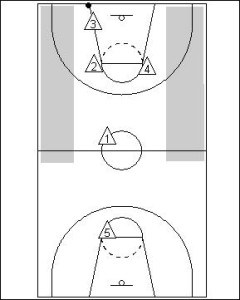
1-2-1-1 Full Court Zone Press is one of the popular full court trapping formations. The variation from that of the standard 1-2-2 provides some additional length to the pressing team’s defensive layers and provides better vision of the court by the last defender (Five).
As with all full court defences the 1-2-1-1 Full Court Zone Press is most affective following a scoring possession or after a foul shot. This is because these scenarios allow for the defensive players to set-up and consolidate their starting position prior to the ball becoming live.
When the ball enters the floor there will be two players trapping, two players as interceptors (marking passes to players one pass away) and one as a safety (Five).
The two preferred trapping areas are indicated in grey. As can be seen in the diagram the opportunity to initiate the trap is very long, in some situations their might be enough area available to trap for a second time within this space.
The defensive players must attempt to stop the ball from coming to the middle of the floor, as this will result in a delay tactic rather than a trapping situation.
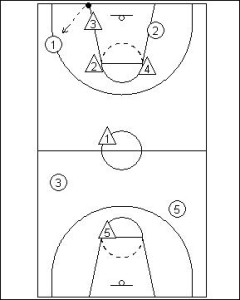
As the ball is inbounded, the players must position themselves so the ball goes toward the trapping areas.
Players who are not involved in trapping the ball will need to deny the pass to the middle and look to intercept the pass down court. They must position themselves accordingly to the offensive players who are one pass away from the ball.
As a teaching point for each step an offensive player takes within a defensive player’s zone, the defender must be moving step for step to be able to react to the movement and correctly position themselves.
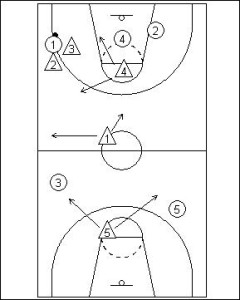
The defenders involved in trapping the ball (Three and Two) must be active in both feet and hands to limit the possibility of breaking through or passing out of the trap.
Active hands by the trapping defenders is a must. The trapping defenders must look to mirror the ball and attempt to have the dribbler put the ball above their head to make a slow and long pass.
As the ball is trapped in the corner or on the sideline, Four (4) denies the pass into the middle of the court.
One (1) denies the pass to the middle and the pass down the sideline.
Five (5) should play behind the last offensive line, looking to intercept any long passes. Depending on how mobile the Five (5) is, this player can look to move up the floor and ply closer to the defenders.

If the horizontal pass is made, Four (4) and Three (3) will now trap.
Two (2) now denies the pass into the middle of the court
One (1) denies the pass down the sideline and the pass into the middle
Five (5) remains behind the last line of offence ready to intercept any long passes.
The exact rotations and movement of players should be communicated by coaching staff once the oppositions press breaker has been scouted and broken down. This will ensure the 1-2-1-1 Full Court Zone Press continues to be effective in creating pressure situations for a team’s opposition even after they have seen and planned for it.
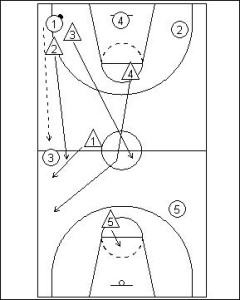
If the sideline pass is successfully thrown, then One (1) must contain the player with the ball. One (1) must look to contain this players dribbles and limit the opportunity for an advantage situation to unfold for the offensive team.
Two (2) must hustle back to double team the ball.
There is an option in this scenario for the secondary rotation to come from the Three (3). This is because the Three (3) can see where the ball was passed. This a common reason sighted for the Three (3) rotating. In the example provided however, it is thought That players would be more familiar rotating and recovering down the lanes they start within initially during the set-up for the 1-2-1-1 Full Court Zone Press.
Four (4) rotates to behind the line of the ball as an interceptor.
Three (3) rotates back to a mid-court split line position.
Five (5) falls back into the keyway as a safety.
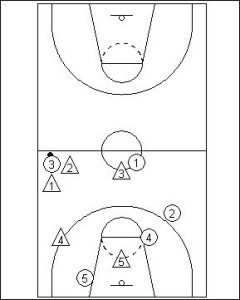
As can be seen the defensive team in any on-ball situation still maintains two defenders trapping the ball, two interceptors and a safety.
Related articles








Leave a Reply